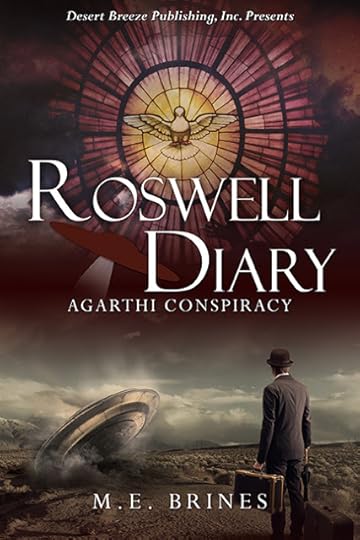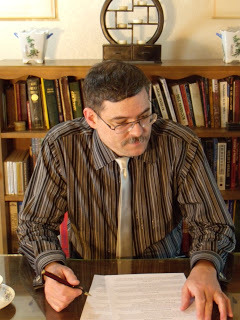Understanding Show, Don't Tell By M.E. Brines
Stuart Mackenzie doesn’t want to be a hero, just an ordinary guy with a wife and a job and a mortgage, but Destiny had other plans.
 A decorated hero in the Second World War, two years later Stuart is nothing but a washed up short order cook estranged from his war-bride wife. Walter, an old army buddy he hasn’t seen since the war offers him a job with the newly organized Central Intelligence Agency doing the same things he was so successful at during the war. But Stuart turns him down. He’d rather just be a regular guy. But when his wife leaves him, he reconsiders. His first mission: investigate the crash of a flying saucer at Roswell, New Mexico. The Air Force claims it was really nothing more than a simple weather balloon, but what are they trying to hide? Join Stuart as he uncovers the truth behind the rash of saucer sightings, their origin in the occult laboratories of Nazi Germany and their influence on the events of the Cold War.
A decorated hero in the Second World War, two years later Stuart is nothing but a washed up short order cook estranged from his war-bride wife. Walter, an old army buddy he hasn’t seen since the war offers him a job with the newly organized Central Intelligence Agency doing the same things he was so successful at during the war. But Stuart turns him down. He’d rather just be a regular guy. But when his wife leaves him, he reconsiders. His first mission: investigate the crash of a flying saucer at Roswell, New Mexico. The Air Force claims it was really nothing more than a simple weather balloon, but what are they trying to hide? Join Stuart as he uncovers the truth behind the rash of saucer sightings, their origin in the occult laboratories of Nazi Germany and their influence on the events of the Cold War.Understanding Show, Don't TellBy M.E. Brines
"Show, don't tell" is commonly repeated advice for writers, but there seems to be a great deal of misunderstanding about the meaning. I know I misunderstood it at first. I mean, writers tell readers things all the time, right? We're tellingthem a story. We have to tell readers about the beautiful sunset, that there's a piano in the background and about that lovely roast simmering in the oven. But description isn't what we mean by telling. Telling is stating story facts bluntly, explaining and handing out conclusions. It's informing the readers of facts you want them to know, rather than allowing them to deduce them for themselves. If you state there's a roast simmering in the oven, you're telling. If you describe heat coming from the oven along with a sizzling noise and the succulent scent of something broiling its own juices down into a thick, beefy gravy – that's showing. If you're writing non-fiction, telling is how it's done. People read non-fiction to get the facts. They want everything set out where they can see it so they understand completely and don't miss anything.But they read fiction for entertainment. They want to watch a story unfold in the movie theatre of their mind's eye. James N. Frey in How to Write a Damn Good Novel called this "dreaming the fictive dream." An author is like the tour guide of a specific daydream. If you're good at it, people won't want to put your book down until the very end. But telling turns the fictive dream into a documentary. Documentaries have narrators whose job is to lecture the ignorant viewers on the pertinent facts and figures so they'll be able to pass the test next Thursday. This is how textbooks read – boring! Nobody reads textbooks for fun. And nobody reads novels for the facts and figures. They get those from Cliff's Notes.But people pay to experience a movie. Movies show what's going on and let the viewer reach his own conclusions. Movies, even bad ones, don't load down the viewer with three paragraphs of back-story whenever a new character comes on screen. They don't spoon-feed viewers by revealing a character's thoughts so they know exactly how a character feels. We have to make our own conclusions from watching the actor's expressions, his actions, hearing the shrill anger in his voice, watching him tremble, seeing his knuckles whiten as he clenches a fist.Movies rarely employ a narrator, and when they do he usually shuts the hell up after the movie gets going. The text at the beginning of Star Wars movies that crawls up the screen into the distance never explained the Force or any of the characters' back-stories. The old noir-style detective films where the protagonist's introductory voice-over ramblings might seem like telling. But even those are just a different style of showing. Sam Spade doesn't come out and tell us he's a low-down womanizing jerk. But when we find out in The Maltese Falcon that he's worried about becoming a suspect in his partner's murder because he's been sleeping with the guy's wife, we get that. It's obvious from their relationship that he's been sleeping with the secretary, too. And it's never overtly stated in the book or movie versions that creepy Joe Cairo is queer as a three-dollar bill, but we get that just by watching the guy. If you're especially clever you figure out the young gangster is his catamite. All that got past the movie censors of the time by being shown not told.Telling gives lengthy explanations of the how, what, when, where, and why that belong in newspaper articles, not prose. It informs readers of conclusions rather than presenting the evidence and allowing them to figure it out for themselves. Description isn't telling unless you include a conclusion. "The homeless man had been living on the street for years," tells. "The man in filthy rags limped along, pushing a battered shopping cart filled with his meager possessions, his expression one of hopes too often betrayed and now abandoned," shows. Good writers show emotions through the use of expressions, body language, dialogue and word choice rather than overusing adverbs or just bluntly telling us "Mary was angry." Telling us why she was angry is even more blatant telling. Such things are usually obvious from context.Actions speak louder than words, and sometimes you can say a lot by what hasn't been said. If a scene opens with a fully dressed man having his breakfast and reading the paper when his wife shuffles in wearing a housecoat and yawning and starts fixing herself something, that he just sits there reading gives the reader a more telling view of their relationship than anything the author could state.The important thing to remember is, readers don't like to be told a bunch of back-story as if there's going to be a test later. They want to watch the movie and come to their own conclusion. Ernest Hemmingway's famous "iceberg writing style" is all about this. In an article on bullfighting, Death in the Afternoon he wrote:If a writer of prose knows enough of what he is writing about he may omit things that he knows and the reader, if the writer is writing truly enough, will have a feeling of those things as strongly as though the writer had stated them. The dignity of movement of an iceberg is due to only one-eighth of it being above water.That said, there are times and places for telling. If you "show" the whole novel you'll end up with Ulysses or One Day in the Life of Ivan Denislovich , which might win you a literary prize, but nobody's going to want to read it for fun. It's okay to skip the boring stuff and just tell the reader what happened. For example, in one of my early novels I included several pages describing a lengthy train journey through Occupied France in World War II during which nothing important occurred. It was a typical train journey, and about as much fun to read about as somebody's daily commute. A critique group said as much and I was clever enough to follow their advice and replace it with a one-sentence comment to the effect that a week later they got off the train in Paris. But for all the interesting scenes where people discover important things about the characters or plot, you want to show, not tell.Show, don't tell by avoiding "was." Besides being passive and weak, declarative sentences are used to state facts, the very definition of telling. Use word search to examine every "was" in your work. Unless they're used in dialogue, odds are when you use was, you're telling the reader instead of showing him.Stay out of your character's heads. Telling readers your character's thoughts and feelings is a cheat that dispenses with showing them through actions and dialogue. And if you do show us those thoughts and feelings elsewhere, there's no point in telling us, too. Not only are you treating readers like imbeciles and spoon-feeding them the story, but then they have to sit through you telling them again what you showed them in the first place.
Remember the fictive dream. That's what your readers want to experience. Every time you stop their mental movie so the narrator can come out from behind the curtain and lecture themon back-story or to make a plot point clear, you risk readers getting bored and leaving the theatre. Textbooks can get away with being mind-numbing. People have to buy those books. But readers aren't required to read yours. Don't make your story come across like a textbook. Show, don't tell.

M.E. Brines spent the Cold War assembling atomic artillery shells and preparing to unleash the Apocalypse (and has a medal to prove it.) But when peace broke out, he turned his fevered, paranoid imagination to other pursuits. He spends his spare time scribbling another steampunk romance occult adventure novel, which despite certain rumors absolutely DOES NOT involve time-traveling Nazi vampires!A former member of the British Society for Psychical Research, he is a long-time student of the occult and a committed Christian who sees himself as a modern-day Professor Van Helsing equipping Believers for battle against the occult Principalities and Powers that rule a world in darkness. (Ephesians 6:12)The author of three dozen books, e-books, chapbooks and pamphlets on esoteric subjects such as alien abduction, alien hybrids, astrology, the Bible, biblical prophecy, Christian discipleship, conspiracies, esoteric Nazism, the Falun Gong, Knights Templar, magick, and UFOs, his work has also appeared in Challenge magazine, Weird Tales, The Outer Darkness, Tales of the Talisman, and Empirical magazine.
M.E. Brines Links
Amazon
Desert Breeze Publishing
M.E. Brines' Web Page
Published on January 23, 2016 13:18
No comments have been added yet.



